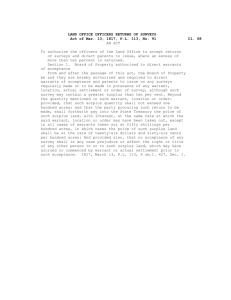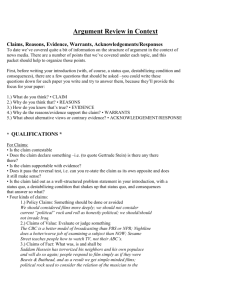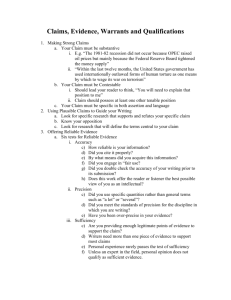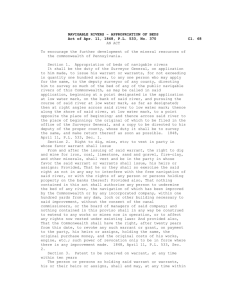The Criminal Bar Association of Victoria, 1 October 2004
advertisement
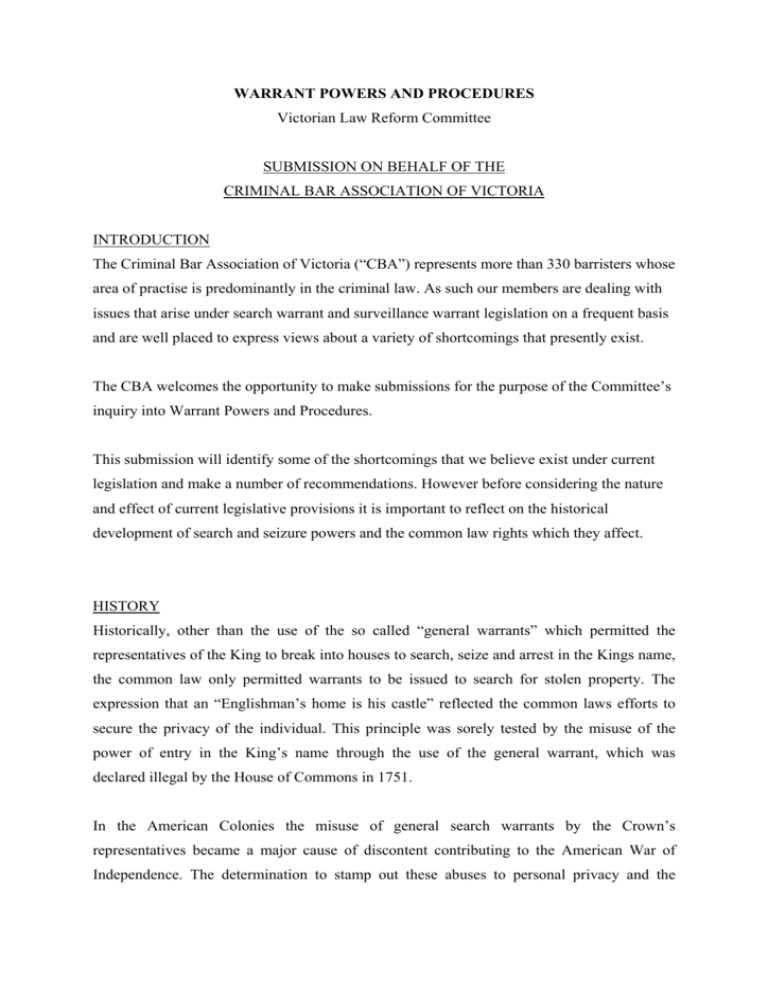
WARRANT POWERS AND PROCEDURES Victorian Law Reform Committee SUBMISSION ON BEHALF OF THE CRIMINAL BAR ASSOCIATION OF VICTORIA INTRODUCTION The Criminal Bar Association of Victoria (“CBA”) represents more than 330 barristers whose area of practise is predominantly in the criminal law. As such our members are dealing with issues that arise under search warrant and surveillance warrant legislation on a frequent basis and are well placed to express views about a variety of shortcomings that presently exist. The CBA welcomes the opportunity to make submissions for the purpose of the Committee’s inquiry into Warrant Powers and Procedures. This submission will identify some of the shortcomings that we believe exist under current legislation and make a number of recommendations. However before considering the nature and effect of current legislative provisions it is important to reflect on the historical development of search and seizure powers and the common law rights which they affect. HISTORY Historically, other than the use of the so called “general warrants” which permitted the representatives of the King to break into houses to search, seize and arrest in the Kings name, the common law only permitted warrants to be issued to search for stolen property. The expression that an “Englishman’s home is his castle” reflected the common laws efforts to secure the privacy of the individual. This principle was sorely tested by the misuse of the power of entry in the King’s name through the use of the general warrant, which was declared illegal by the House of Commons in 1751. In the American Colonies the misuse of general search warrants by the Crown’s representatives became a major cause of discontent contributing to the American War of Independence. The determination to stamp out these abuses to personal privacy and the derogation of rights and freedoms led to the Fourth Amendment to the United States Constitution which was adopted in these terms: “The rights of the people to be secure in their persons, houses, papers and effects, against unreasonable searches and seizures, shall not be violated, and no warrants shall issue, but upon probable cause, supported by oath or affirmation and particularly describing the place to be searched and the persons or things to be seized.” Similar provisions exist in the recent South African Constitution, which attempts to redress the imbalance created by the apartheid regime. The entrenchment of rights and freedoms as part of a Constitutional doctrine is invariably the product of fundamental human conflict. Australia has not experienced the upheaval of 18th Century America, or the turmoil of a racially divided South Africa. We have no equivalent to the overriding obligations laid down in the Fourth Amendment; nevertheless, the common law both in England and in Australia has vigilantly defended the privacy of the individual and his or her dwelling from intrusion, unless clearly authorised by law. In George v Rockett (1990) 170 CLR 104, a case concerned with the execution of a search warrant issued under s.679 of the Criminal Code Qld and executed on the office of the solicitors acting on behalf of former Police Commissioner Sir Terrence Lewis, the High Court said: -(pages 110-111) “The common law has long been jealous of the prima facie immunity from seizure of papers and possessions;…except in the case of a warrant issued for the purpose of searching a place for stolen goods, the common law refused to countenance the issue of search warrants at all and refused to permit a constable or government official to enter private property without the permission of the owner. Historically, the justification for these limitations on the power of entry and search was based on the rights of private property. In modern times the justification has shifted increasingly to the protection of privacy. …State and Commonwealth statutes have made many exceptions to the common law position and s.679 is a far reaching one. Nevertheless, in construing and applying such statutes, it needs to be kept in mind that they authorise the invasion of interests which the common law has always valued highly and which through the writ of trespass, it went to great lengths to protect. Against that background, the enactment of conditions, which must be fulfilled before a search warrant can be lawfully issued and executed, is to be seen as a reflection of the legislature’s concern to give a measure of protection to these interests. To insist on strict compliance with the statutory conditions governing the issue of a search warrant is simply to give effect to the purpose of the legislation.” Three propositions which emerge from George v Rockett are:i). The Courts will insist upon the strict compliance with the statutory conditions governing the issue of search warrants. ii). Where a statute imposes a duty upon the issuing officer to be satisfied about a particular matter, the issuing officer must be so satisfied. iii). The warrant or notice must disclose jurisdiction of its face. These propositions underpin most subsequent authority concerned with the issue or execution of search warrants. In Crowley v Murphy (1981) 34 ALR 496 Lockart J. listed some of the procedures that policemen should follow when executing a search warrant:“First, like most statutory powers, the power of enforcing a search warrant, must be exercised in good faith. Second, the power must be exercised for the purpose for which it was conferred. It must not be used for some ulterior purpose. Third, the power must be exercised fairly, having regard to all the circumstances. Fourth, it must be exercised having regard to those affected by its exercise. Fifth, the officer executing the warrant must strictly follow the directions contained in it and must not exceed the limits of authority it confers.” In the course of any criminal investigation search warrants are an effective method of searching for and seizing items as potential evidence. But it is the very nature of this power and its exercise that represent significant risks to individual freedoms and which have led the courts to insist upon strict compliance. The observations in George v Rockett and in Crowley v Murphy are applicable to all warrants issued under the variety of legislative schemes that exist under Victorian law, in particular s.465 of the Crimes Act 1958, s.81 of the Drugs Poisons and Controlled Substances Act 1981 (which pick up the general warrant provisions of the Magistrates Court 1989) and the provisions of the Surveillance Devices Act 1999. These are the State legislative provisions that are most frequently used by Victorian Police in criminal investigations. SEARCH AND SEIZURE WARRANTS Issue and Execution It is the view of the CBA that legislative provisions which provide for the issue and execution of search warrants should be unambiguous, consistent and above all designed to ensure that individual freedoms are not affected beyond that authorised by the terms of the specific warrant. This requires there to be sufficient specificity in both the warrant provisions and in the warrant itself of what is and is not authorised. A lack of specificity and clarity results in uncertainty and thereby the potential for abuse and the undermining of individual freedoms. Neither s.465 of the Crimes Act (including the provisions of the Magistrates Court Act 1989) nor s.81 of the Drugs Poisons and Controlled Act provide sufficient specificity. They are couched in very general terms and fail to provide to either the executing officer or the owner/occupier sufficient information about what is and is not permitted. The inevitable result of these general provisions is that the rights and obligations of the parties lack clarity and precision. The CBA recommends the adoption of model warrant provisions with respect to search warrants that are utilised in the course of a criminal investigation. We urge the Committee to consider the provisions of Part 1AA of the Crimes Act 1915 (Cth) as representing an appropriate model in relation to issue and execution. Part 1AA contains some of the requirements that are presently found in s.465 of the Crimes Act and s.81 of the Drugs Poisons and Controlled Act but provides far greater detail of the requirements justifying the issue of a warrant and what is authorised by the warrant. Section 3E(1) states “An issuing officer may issue a warrant to search premises if the officer is satisfied by information on oath that there are reasonable grounds for suspecting that there is, or there will be within the next 72 hours, any evidential material at the premises”. An “issuing officer” is a magistrate, a justice of the peace or person employed in a court of a State or Territory who is authorised to issue warrants (s. 3C). “Evidential material” means a thing relevant to an indictable or summary offence and “offence” refers to any offence against the laws of the Commonwealth (except the Defence Force Discipline Act 1982) or the Territory (other than the ACT) (S.3C). Significantly sections 3E(5) prescribes what must be stated in a search warrant and section 3E(6) what it authorises. Section 3E(5) mandates that the warrant is to state: (a) the offence to which the warrant relates; and (b) a description of the premises to which the warrant relates or person to who it relates; and (c) the kinds of evidential material that are to be searched for under the warrant; and (d) the name of the constable who is responsible for its execution; and (e) the period for which the warrant remains in force, which must be no longer than 7 days; and (f) the hours during which the warrant can be executed. Sections 3E(6) requires the issuing officer to also state in a warrant that it authorises the seizure of evidential material found in the course of the search or a thing relevant to another offence that is an indictable offence if the executing officer believes on reasonable grounds that seizure of the thing is necessary to prevent concealment, loss or destruction or use in committing an offence. Once issued section 3F(1) states what an executing officer is authorised to do in executing the warrant including: (a) to enter the premises; and (b) to search for and record fingerprints and samples for forensic purposes; and (c) to search the premises for and seize the kinds of evidential material specified in the warrant. Amongst the remaining provisions within this legislative scheme:Section 3H states that details of the warrant are to be given to the occupier; Section 3J permits the taking of photographs including video recordings for purposes incidental to the execution of the warrant; Section 3K allows equipment to be taken onto the premises to facilitate the examination and processing of documents; Section 3L authorises the accessing of computers, the printing of documents, the copying of disks and the seizure of computers and disks. Section 3N requires the provision of copies to the occupier upon request of all things seized. Section 3ZX states that Part 1AA does not affect the law relating to legal professional privilege In addition to these provisions we also recommend that the following be considered:i). A requirement that searches be videotaped unless in all the circumstances it is impracticable; the onus being in the executing officer. ii). A provision requiring the presence of an independent third person if in the view of the issuing officer it is desirable. Legal Professional Privilege The CBA believes that the protections of legal professional privilege ought not to be eroded and that to the extent that it is possible, appropriate safeguards should enacted. Difficulties will arise because it is not always easy to determine when the privilege attaches. The doctrine of legal professional privilege developed at common law to protect the confidentiality of communications passing between a client and his or her legal advisor. In Carter v. Managing Partner, Northmore Hale Davy and Leake (1995) 183 CLR 121 the privilege was explained in the following terms: “Now that this Court has held that legal professional privilege is not a rule of evidence but a substantive rule of law, the best explanation of the doctrine is that it is "a practical guarantee of fundamental, constitutional or human rights". By protecting the confidentiality of communication between lawyer and client, the doctrine protects the rights and privacy of persons including corporations by ensuring unreserved freedom of communication with professional lawyers who can advise them of their rights under the law and, where necessary, take action on their behalf to defend or enforce those rights. The doctrine is a natural, if not necessary, corollary of the rule of law and a potent force for ensuring that the equal protection of the law is a reality”. (at 161 per McHugh J.) Whilst the rational behind the privilege can readily be explained, the manner and extent of the privilege and its application has proved more difficult. Not all communications are protected. The privilege extends to communications or documents concerned with the obtaining of legal advice or contemplated legal proceedings. The privilege does not extend to communications or documents made or brought into existence for the purpose of, or as part of the process of crime, fraud, abuse of statutory powers or, in some circumstances, defeating or frustrating the administration of justice by the courts, Carter at 134-135 per Deane J. The circumstances in which the privilege might attach extend beyond the giving of evidence and include the discovery of documents or the execution of a search warrant (Mann v Carnell (1999) 74 ALJR 378; Baker v Campbell (1983) 153 CLR 52). Curiously, the privilege whilst not attaching to original document might attach to copies made of those documents if the copies were made for the purpose of obtaining legal advice or for contemplated legal proceedings (Commissioner AFP v Propend Finance Pty Ltd (1997) 188 CLR 501). Until recently, the purpose test for determining the application of legal professional privilege was the sole purpose test (Grant v Downs (1976) 135 CLR 674). In Esso Australia Ltd v Commissioner Taxation (1999) 74 ALJR 339 the High Court by majority (McHugh and Kirby JJ. dissenting) held that the dominant purpose test as developed by the common law and not the sole purpose test as laid down in Grant v Downs was the applicable test in Australia. In reaching this conclusion the Court was influenced by sections 118 and 119 of the Evidence Act 1995 (Cth) which applies the dominant purpose test to the adducing of evidence. Their Honours saw the need for a uniform approach throughout Australia as being desirable and consistent with the rule of law. Lawyers Offices Issues of legal professional privilege often arise in the execution of search warrants particularly when a lawyer’s office is involved. If during the execution of a search warrant documents are seized that may give rise to a claim for legal professional privilege, the documents should be identified and the claim communicated to the executing officer. In respect of the execution of search warrants upon lawyer’s offices, procedures have been agreed between the Australian Federal Police and the Law Council of Australia. These were first put in place in 1990 and the current procedures adopted in March 1997. In short the agreed procedures state: i). That application for a search warrant on a lawyer’s office shall only be made after consultation with the office of the Commonwealth DPP. ii). Where a claim of legal professional privilege is made, no member of the police search team will inspect any documents to which the claim relates until either (a) the claim is abandoned or (b) the claim is dismissed by a court. iii). All documents for which a claim is made shall be placed in a sealed container and placed forthwith into the custody of the magistrate or justice who issued the warrant or an agreed third party. iv). The claimant has 3 working days to inform the executing officer of the intention to institute a claim and when proceedings to institute the claim have been instituted the sealed documents are to be delivered into the possession of the Registrar of the Court. The procedures also provide for the resolution of the claim between the parties potentially obviating the need to go to court. This usually involves the appointment of independent lawyers to assess the documents in question and to determine the merits. It is a quicker and cheaper option and often results in the resolution of the matter, although problems do arise with respect to copy documents following the decision in Propend. It is not always easy to determine whether the copy was made for purposes which in Propend were identified as sufficient to attract the privilege. In Victoria a similar protocol has been adopted between the Victoria Police, the Victorian Bar Council and the Law Institute. Pursuant to the protocol if during a search (whether of a lawyers office or otherwise) a claim is made for legal professional privilege the documents are sealed and taken before the Court where the claim can be determined. Whilst this protocol ensures that the privilege once claimed is protected, it doesn’t have the flexibility of the protocol between the AFP and the Law Council of Australia which provides a simpler method of resolving claims without the need to involve the Courts. We recommend that a similar protocol be adopted in Victoria so that a claim of legal professional privilege can be quickly and efficiently determined. Return of the Warrant The introduction of such a protocol may require some modification to the present requirement that all documents seized be brought before the Court to be dealt with according to law. This requirement, which is unique to Victoria, is a safeguard that we believe should otherwise be retained. It provides an early opportunity to assess whether the terms of the warrant have been complied and whether the retention of seized items is justified. Presently the return of the warrant is conducted in Chambers before a Magistrate and usually in the absence of the affected party, who is unlikely to know of the procedure. We recommend that it be a requirement for the executing officer to give notice to the affected party of the date and time of the appointed hearing on the return of the warrant, thereby giving the opportunity to raise matters touching upon the process. We note the comments of Professor Richard Fox that the requirement that all documents seized be brought before the Court is not always complied with. Arguably such a failure would render the continued retention of property unlawful. A requirement to give notice to the affected party should prevent this from occurring. Reporting and Records We agree with the Committees endorsement of the comments of the Law Reform Committee which examined The Powers of Entry, Search, Seizure, Questioning and Detention by Authorised Person in October 2001; this is found at page 37 of the Discussion Paper. The greater the level of accountability that is imposed on police and the Courts at each stage of the process the greater the likelihood that there will be strict compliance governing the issue and execution of warrants. We recommend that accountable records be maintained by both police and the Court of each warrant issued, of each warrant executed and of all items seized. We also recommend that the Ombudsman’s office fulfill an independent role ensuring compliance. The provisions of Part VIII of the Telecommunications (Interceptions) Act 1979 (Cth) provide a model that we endorse. SURVEILLANCE DEVICE WARRANTS In Victoria the use of listening devices, optical surveillance devices, tracking devices and data surveillance devices is governed by the provisions of the Surveillance Devices Act 1999. Unlike search warrants where notice is provided to the owner/occupier prior to execution, a surveillance device warrant is clandestine. In Grollo v Palmer (1995) 184 C.L.R. 348 at 367 the Court said “[t]he decision to issue a warrant [for a listening device] is, for all practical purposes, an unreviewable in camera exercise of executive power to authorise a future clandestine gathering of information”. The secrecy that attends all stages of the issuing and execution of surveillance device warrants is a matter of concern. Whilst it is understandable that there is a requirement for secrecy, an appropriate balance must be maintained between the use of these devices and the protection of individual rights. This is especially so given the proliferation of surveillance device warrants and the enormous quantity of recorded product that is obtained. In this regard we endorse the comments and concerns of Brian Walters S.C. at page 60 of the discussion paper. The capacity for the misuse of warrants is a matter of considerable concern. To ensure that there is an appropriate balance we make to following recommendations:i). The preconditions for the issue of a surveillance device warrant be tightened. ii). There be greater clarity of the circumstances under which a warrant is required. iii). The duration of a warrant be reduced from 90 days to 30 days. iv). Prior to there being an extension of an existing warrant, justification for the extension should be demonstrated from the product previously recorded. v). Accountable records be kept of all warrants issued and executed. vi). The agency to whom the warrant is issued be required to report to the issuing officer and/or the Omdudsman on the nature and quantity of the product recorded under the warrant. vii). Time limits be imposed on the retention of the recorded product. viii). Greater penalties be imposed for a breach of any of the prohibitions imposed by Surveillance Devices Act. Illegally Obtained Evidence In this context we urge the Committee to consider a departure from the common law position with respect to illegally obtained evidence, which is admissible in Court but is susceptible to exclusion by the Court in the exercise of its discretion. The discretion to exclude illegally obtained evidence has developed under the common law and exists to enable to Courts to enforce the rule of law. It is based upon “high public policy” and exists to serve a number of purposes, including: (a). The right of Society to insist that those who enforce the law respect it; Bunning v Cross (1978) 141 CLR 54 at 75 per Stephen & Aickin JJ. Pollard v The Queen (1992) 176 CLR 177 at 203 per Deane J. (b). The protection of citizens from improper or unlawful treatment; (protection of civil liberties or rights) Bunning v Cross at 77-8 per Stephen & Aickin JJ. (c). To enable the Courts to protect the integrity of their processes; (no curial approval for wrondoing) Bunning v Cross at 78 per Stephen & Aickin JJ. (d). To prevent the administration of justice being brought into disrepute; (to maintain public confidence in the administration of justice) Bunning v Cross at 78 per Stephen & Aickin JJ. Pollard at 202 per Deane J. However, whilst these ideals might appear to provide a sufficient justification for the exclusion of illegally obtained evidence, in practice it is only in a few rare instances that evidence of this kind is excluded. This is primarily because the onus of establishing the necessary criteria for exclusion rests on an accused who forensically is in a position of disadvantage. This is especially so with respect to evidence obtained under a surveillance device warrant where the circumstances of its issue and its use is often protected by claims of public interest immunity. Accordingly, we recommend the adoption of provisions similar to s.77 of the Telecommunications (Interceptions) Act 1979 (Cth) which renders illegally intercepted communications inadmissible in Court. Alternatively, at the very least illegally recorded material should be rendered inadmissible subject to the establishment by the prosecution of exceptional circumstances justifying its reception. The benefit of such a variation to the common law position is as follows:i). It helps to redress the imbalance that presently exists by virtue of the secrecy and lack of scrutiny that shrouds the use of these devices. ii). It places an onus on law enforcement officers to ensure that the conditions governing the use of these devices are strictly complied with. We thank the Committee for the opportunity to make these submissions and hope to participate in the public hearings. Stephen Shirrefs SC Vice- Chairman



